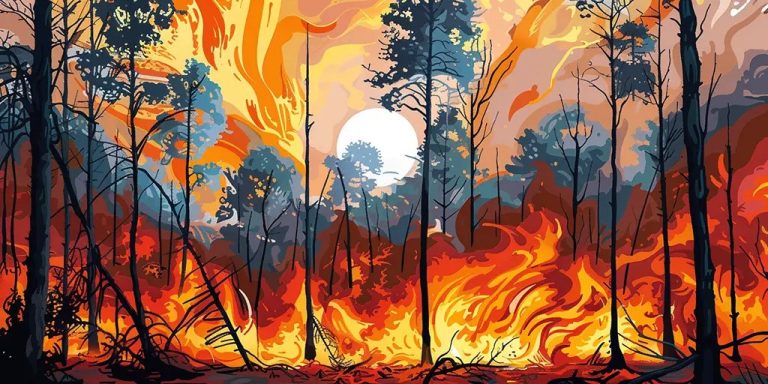Jim Steele
Shocking cherry-picking by alarmist climate scientists in an attempt to deceive the public into believing that the slight increase in area burned by wildfires can be blamed on rising carbon dioxide concentrations. First, they dishonestly ignore scientific evidence that far more fires occurred before the 1930s, when carbon dioxide and global temperatures were much lower than today (Figure A).

Nonetheless, clickbait media “scientist” Daniel Swain myopically believes that because of his guidance from alarmists Michael Mann and Noah Diffenbaugh, every Every negative environmental change is the result of rising carbon dioxide emissions. Not surprisingly, then, Swain mistakenly asserts that “recent research suggests that anthropogenic climate change is rapidly altering fire regimes in the Western United States (WUS), producing overall more extreme wildfires.”
Sadly, Swain is just a useful idiot in the World Economic Forum's push for global governance, claiming that “slowing and reversing the accumulation of carbon dioxide and other greenhouse gases in Earth's atmosphere will slow the acceleration of wildfire risks.”
(https://x.com/JimSteeleSkepti/status/1814681971664052663/photo/1)
Although there is evidence that heat waves do not have a significant impact on grassland flammability, Swain believes that any major heat wave “is more likely to occur and have higher temperatures than would otherwise occur due to human-caused climate change.” But areas that experience cooling trends, like the U.S. Warm Hole, also experience extreme heat waves.
READ: Heat wave science revealed Blame CO2 a hoax! https://x.com/JimSteeleSkepti/status/1799125891731329105

To push the link between the climate crisis and wildfires, dishonest scientists single out wildfires in California and the American West as evidence of the climate crisis. But the western United States is naturally much drier than the eastern United States (Figure B), making it more prone to more frequent and widespread fires. People outside the western United States (and outside southern Europe with similar climates) are surprised to find that in California's Mediterranean climate, there is almost no rainfall in the summer (Figure C), resulting in natural dryness that can lead to more fires.

Additionally, dishonest scientists mistakenly drive climate change by ignoring the relationship between naturally dry climate and flammable vegetation. Dishonest scientists avoid describing easily ignited grasslands and shrublands that are three times the size of forest fires. Grass and shrubs are split into 1 hour and 10 hour fuel as they will turn into Highly flammable during days of dry weather regardless of climate change. exist Prescribed burning in California’s Mediterranean ecosystem Green (1982) suggested that fully prescribed burning can be conducted in grassy areas “shortly after a storm” and within a few days in small brush.

Prairies cover much of California (brown, Figure D). During California's natural summer droughts, grasslands are the most fire-prone habitat. Dead grass and brush are the easiest, fastest spreading and most widespread wildfires to ignite. Grass and shrubs fuel California's largest fires, as currently happening with California Park Fires. Wildfires occur less frequently in forested areas (Figure E) and are often driven by dead grasses and shrubs that provide pathways for fires to enter the forest floor and provide sufficient heat for ignition. Grass fires burn at 1000+ degrees Fahrenheit. Temperature increases of just 2.7 degrees Fahrenheit (1.5 degrees Celsius) due to climate change have no impact on the ability of grass fires to ignite undergrowth and debris on the forest floor.

In the past, grass fires would travel across the forest floor but not burn trees. However, 20 years oldth century Fighting fires causes brush and debris to accumulate and provides the more heat needed to ignite larger logs (1000 hours of fuel) and trees.
Between grasslands at lower elevations and forests at higher elevations, tussocks carry fire into open oak woodlands (dark green, Figure D), a common habitat around the Chico and Park fires (Figure F). Grass elsewhere carries fire into brush/brush (Figure G). The current Park Fire has spread rapidly through these grasslands and is now the seventh largest fire in California to dateth The biggest fire.

For California and much of the western United States, annual grasses die in early summer and naturally become highly flammable from June to September as their fuel moisture content drops below 10%. Summer heat waves increase average maximum temperatures by a few degrees but do not significantly increase grass flammability. Indicators of higher vapor pressure deficit also do not further affect the flammability of dead grass.
Yet alarmists keen to attribute the fires to climate change rarely point to the increased biomass of highly flammable invasive annual grasses in the American West. Nonnative grasses, such as daylily, have invaded increasingly larger areas of habitat (Figure H), with daylily accounting for the majority of the area burned by wildfires (compare Figures B and H). A wet El Niño further increases the amount of grass available for fire fuel in the coming year.
Finally, contrary to Swain's alarmist assertion that Butte County (i.e., the Park Fire) has become a “poster child” over the past decade for what can happen when a warming climate triggers extreme summers and winters, Swain ignores the local temperatures and U.S. of climate change. Therefore, there is no scientific evidence to support Swain and the World Economic Forum's false narrative that global warming has caused “a five-fold increase in the likelihood of extreme heat waves over the past 150 years.”
Carbon dioxide does not cause “more extreme wildfires”!
(Read: Heatwave science revealed: Blaming CO2 a hoax!
https://x.com/JimSteeleSkepti/status/1799125891731329105)
related
